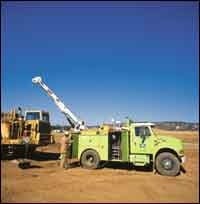Truck-mounted service cranes not only act as important maintenance tools but as jobsite tools as well. Their maintenance function is that of lifting heavy components and they are generally teamed with a service truck. As general lifting equipment on the jobsite, service cranes can lift, carry and place materials. And the large number of models available means that there's a crane for every application.
Most service cranes serve as part of the maintenance package. The two types of cranes are the articulated and the telescopic models. Each has advantages and disadvantages, depending on the application. Articulated cranes have a lot of lifting capacity for their size, but lack the reach of a telescopic crane. The articulated units can be used for load-and-carry operations because they can be mounted on a flatbed truck and fold away at the front of the bed, leaving virtually the whole bed for carrying cargo. Articulated cranes also can reach below the truck bed and over obstacles. Where reach coupled with capacity are needed, the telescopic crane is the crane to use. Many crane models are hybrids, with articulation plus a telescoping feature.
Regardless of the type of crane selected, it's important that the crane and truck be matched in terms of size. Many times the crane and truck are purchased as a package. But if the crane and truck are purchased separately, the crane manufacturer's specifications will state the carrier size required, given in gross vehicle weight rating, front and rear axle load, and other parameters required for safe crane installation and operation.
Don't let the crane's size or apparent simplicity fool you. Service cranes have come to be equipped with many of the features found on larger cranes, either as standard or optional equipment. Iowa Mold Tooling (IMT), for example, now equips its articulated cranes with its Electronic Vehicle Stability (EVS) safety system. The EVS system evaluates and adjusts vehicle stability by monitoring the load moment and movement of the crane. It then compares these factors with the actual stability of the vehicle. If the operator approaches the vehicle's stability limit, the EVS system informs the Rated Capacity Limitation (RCL) safety system, which warns the operator both visually and audibly. After this, the EVS system will permit the operator to activate only those crane movements that will improve stability.
According to IMT, the EVS system lets the operator utilize the full capacity of the crane within the capacity of the vehicle, resulting in more effective and safe operation.
In addition to the new EVS system, IMT also has introduced its largest articulated cranes to date, the 52/380 and 72/516, which have rated capacities of 358,755 ft.-lbs. and 487,505 ft.-lbs., respectively. At the other end of the line are the new HandyCranes—lightweight, compact units requiring minimal mounting space. The three models range in capacity from 3,620 to 12,295 ft.-lbs.
Another example of service-crane sophistication is the Smart Crane diagnostic system found on the Auto Crane line. It provides instant feedback on key crane performance indicators. The Series 5005H telescopic cranes also have a Rotation Speed Control (RSC) that includes a two-speed rotation mechanism that increases the rotation speed of the crane when unloaded and decreases the speed under load. Both a radio remote and 24-foot tethered remote are included, with fully proportional crane control. Other features offered on various Auto Crane models include automatic overload protection and anti-two block systems.
Crane size does not dictate technology as evidenced by Stellar Industries' sophisticated remote control on its smaller models. The control is a fully proportional radio remote. The remote incorporates a proportional "trigger" that allows the operator to feather the crane for precise control. Also, the remote control handle includes engine start/stop functions, compressor on/off, engine speed controls, and an emergency shut-off.
Other Stellar developments include the X-Tender, a self-storing jib boom, available for the model 10620 telescopic crane. It provides another 30 feet of reach and, when not in use, it folds against the outer boom section by removing a pin and rotating the jib boom.
Despite the technological innovations incorporated into service cranes, they still remain an economical investment. Given their relatively long life, the initial cost of the crane spreads out over as much as 15 years. Even when a crane reaches the end of its effective life, many units are retired to secondary uses for several more years. Overall, articulated cranes outlast telescopic cranes, depending on work activity and use hours.
| Web Resources | ||
| Auto Crane www.autocrane.com | IMT www.imt.com | |
| Maintainer www.maintainer.com | National www.manitowoccranegroup.com | |
| Stahl www.stahl.cc | Stellar www.mechanictruck.com | |
| Tiger Line www.fabcor.com | ||







